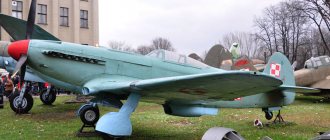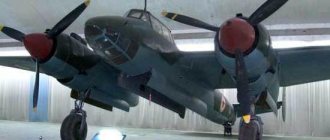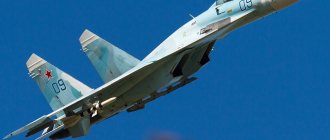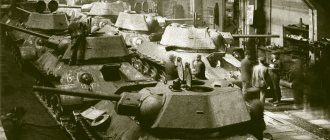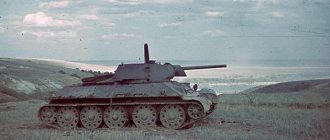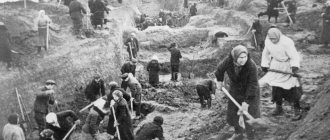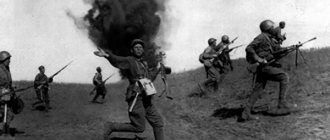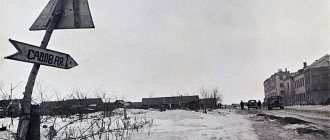How often do people talk about the merits of the winners of the Great Patriotic War, but have they ever thought about those who stood at the origins of the all-Union victory? One of those who made a tangible contribution to the history of invincible Soviet aviation is aircraft designer Semyon Lavochkin.
It was his work that created the famous line of front-line fighters La-5 and their development La-7. The famous I.N. fought on these planes. Kozhedub, three times awarded the title Hero of the USSR for victories in air battles.
Biography
Semyon Alekseevich Lavochkin, was born in the family of melamed Alter Ilyich Lavochkin and housewife Gita Savelyevna on August 29, according to the new style on September 11, 1900. He is an ethnic Jew, a native of Smolensk.
In Roslavl he graduated from the city school, after which he was enrolled in the Kursk gymnasium in 1917, from which he successfully graduated with a gold medal.
In 1918, he joined the Red Army, and in 1920 he became a border guard employee. He was demobilized at the end of 1920 and was sent to study in Moscow.
Already undergoing pre-graduation practice, Semyon Alekseevich Lavochkin became part of the history of Soviet aviation, passing it at the Tupolev Design Bureau.
The entire life of the legendary Soviet aviation designer Semyon Alekseevich Lavochkin was spent at work. This is reflected in his biography.
After he graduated from the Higher Technical School in Moscow, the aspiring aircraft designer S. Lavochkin worked under the guidance of various designers and engineers, which later determined his view of the aircraft, completely devoid of stereotypes, and therefore not blurred.
- 1929, OPO-4, work under the direction of Paul Richard. Legendary seaplane designer;
- 1930, work at the Bureau of New Designs under the leadership of Henri Laville, one of the engineers of Paul Richard’s team, who by this time had left the USSR, among the projects being developed at that time was the heavy fighter DI-4, in the development of which Lavochkin also took part;
- 1939 OKB-301. Semyon Alekseevich Lavochkin, together with Gorbunov and Gudkov, are participating in a competition to create a new fighter to replace the I-16. The I-301 prototype they presented, nicknamed “piano” due to its cherry-colored varnish and varnish, went into mass production in 1940 under the name LaGG-3;
- 1941 OKB-21, work on the modernization of the LaGG-3 fighter; until 1944, 66 series of this aircraft were produced, changing from release to release. Launch of the legendary La-5 into mass production and further work on its modernization;
- 1945 OKB-301. From that moment until the end of his design career, Lavochkin worked in this design bureau.
The great aircraft designer Semyon Alekseevich Lavochkin liked to repeat that a true professional does not just need an office, he needs an entire factory. And to create a masterpiece, ink, ink and paper are not enough; you need workers, tools and materials to make an aircraft.
The beginning of the 1930s, Spain is plunged into civil war, the USSR begins supplying weapons and equipment there. Along with combat aircraft, Soviet volunteer pilots also take off into the skies of Spain, who not only performed the work of instructors, but also carried out combat activities.
The battles in the hot skies of Catalonia showed that the I-16, although it does not step, is not yet inferior to the German Bf.109B aircraft that were in service with the Condor air wing. But, nevertheless, it becomes outdated extremely quickly. A competition to re-equip the aviation of the Soviet Union, in which young aircraft builders took part, was called upon to eliminate the backlog:
- Lavochkin, Gudkov and Gorbunov, the LaGG-3 fighter, an aircraft with powerful weapons, an M-105P engine, the basis of the design of which was the massive use of bakelite plywood - delta wood;
- Mikoyan and Gurevich - MiG-1 fighter, AM-35 engine, high-altitude high-speed fighter;
- Yakovlev A.S. with the Yak-1 front-line fighter, M-105P engine, lightweight plywood-canvas construction, armament in the form of a 20 mm motor cannon and two machine guns.
It was these aircraft that subsequently met the first blow of the Third Reich, and their successors knocked out the Luftwaffe personnel, providing the advancing army with complete air superiority.
Krasvozduh
Semyon Alekseevich Lavochkin, famous Soviet designer of aviation and rocket technology
Semyon Alekseevich Lavochkin is a designer who became the first in many areas of aviation and rocket technology. The first Soviet aircraft with SAWWAY
wing
The first SUPERSONIC flight. The first CRUISED INTERCONTINENTAL
missile
. The first anti-aircraft missile . Semyon Alekseevich Lavochkin had the talent of foresight; he could look far into the future! He knew how to find solutions that led to the creation of new level technology. He also did not forget and understood what requirements the equipment must meet at the current moment. Semyon Alekseevich Lavochkin was not only a talented, but also a truly sympathetic person ! Among famous and famous people, NOT is responsive .
Semyon Alekseevich Lavochkin in childhood with relatives
Smolensk is one of the oldest cities in Russia. in the Smolensk region ! Gleb Vasilievich Alekhnovich was born Smolensk itself Mikhail Nikiforovich Efimov and many other famous in the Smolensk region . The world's first cosmonaut, was also born in the Smolensk . In 1900, on September 11th in Smolensk was born into the family of a teacher . His parents could not even imagine that their son would become one of the leading aircraft designers of the USSR. Lavochkin studied very well at school and graduated with a gold medal in 1917 , but he was unable to enter college because revolution .
Semyon Alekseevich Lavochkin while studying at the institute
Semyon Alekseevich Lavochkin joined the army voluntarily and served as 3 . Thanks to his abilities, in 1920 the command sent Lavochkin to study at the Moscow Higher Technical School (today Bauman MSTU ). Semyon Alekseevich Lavochkin entered the aeromechanical faculty.
Semyon Alekseevich Lavochkin, famous Soviet designer of La-5 fighters
At that moment, this faculty was NOT PRESTIGIOUS. At that time, as a result of the civil war, the situation in our country was very difficult! Students had to not only study, but earn their living ! In addition, Lavochkin also had to help his family, so he studied at the institute for almost 9 years, until 1929 . In youth , hardships are easier to bear. As a part-time job, at night, draw, count and write student assignments for someone , which Semyon Alekseevich Lavochkin additional for himself . Such work in slang was called “going to the lighters,” that is at night or doing some kind of student work by the light of lighters and candles! Of course, Semyon Alekseevich Lavochkin tried preferably take those jobs that were in his specialty!
TB-1 bomber in the design of which Semyon Alekseevich Lavochkin took part. This copy is equipped with a ski chassis
However, Semyon Alekseevich Lavochkin was generally sociable person with a broad outlook. In addition to professional topics, he was interested in poetry, painting, went to theaters and creative evenings by V.V. Mayakovsky and S.A. Yesenin. He even enrolled in courses on the history of foreign relations. In general, if Lavochkin had not become an aircraft designer, it is quite possible that he would have become, for example, a promising diplomat. He knew how to build relationships with people. He had pre-graduation practice the A.N. Tupolev Design Bureau ( see article “Andrei Nikolaevich Tupolev”) .
TB-1 bomber in the design of which Semyon Alekseevich Lavochkin took part
Semyon Alekseevich Lavochkin’s diploma work was a bomber project. It so happened that after graduation he took part in the creation of a bomber. In the summer 1927 serial construction heavy bomber began at the aircraft plant in Fili . It was the first Soviet serial all-metal bomber. Participation in the design of the TB-1 was Lavochkin first experience in aircraft design. He dealt with issues of strength.
Semyon Alekseevich Lavochkin after the war
After 2 years, Semyon Alekseevich Lavochkin ended up in the design bureau of the French aircraft designer Richard, who was specially invited to the USSR to create a seaplane (see article by G.M. Beriev ). In this project, Semyon Alekseevich was appointed head of department . However, for 3 years of work, Richard’s design bureau did not create anything worthwhile and the design bureau was disbanded. After this, Richard's deputy, Henri Laville, independently began to design the two-seat Di-4 fighter He entrusted the young specialist Lavochkin with designing the layout of the aircraft. This work forever tied Semyon Alekseevich Lavochkin to the FIGHTERS! Despite the fact that French aircraft designers were NOT so successful in creating new technology, they still had some positive role for Soviet aviation. They were good mentors and knew how to organize aviation production and what was needed for this. Therefore, they generously passed on this experience to young specialists, including Semyon Alekseevich Lavochkin.
Fighter of Semyon Alekseevich Lavochkin La-190
In the 1930s was rapidly in our !!! Aircraft designers were actively searching and designing everything from light sport aircraft to front-line bombers. At factories, some design bureaus were closed, new ones were opened in their place , and no one was surprised by the constant transfer of employees from one design bureau to another. In the mid- 1930s, Semyon Alekseevich Lavochkin , together with S.V. Ilyushin (see article “Sergei Vladimirovich Ilyushin” ), was invited to participate in one of the most interesting projects of that time, the creation of a special fighter . Lavochkin was invited by the then famous inventor of dynamo jet guns L.V. Kurchevsky to design a fighter aircraft such guns were to be installed . Kurchevsky's dynamo jet guns turned out to be unsuitable for use on aircraft due to their low rate of fire and short firing range. Accordingly, this project was stopped.
Fighter of Semyon Alekseevich Lavochkin La-200
In the course of inventive and design activities there are always MISTAKES, which are inevitable in NEW business. But at that time it often happened that these truly objective , ordinary shortcomings were equated with deliberate sabotage. Accordingly, there was a danger other participants in the project, including would suffer along with Kurchevsky . At this difficult moment, Lavochkin received an offer to move to A.N. Tupolev’s design bureau, which he immediately agreed to, including for the reason of saving himself from possible repression. Semyon Alekseevich Lavochkin was sent to the department, the head of which was V.P. Gorbunov. It was Gorbunov proposed the creation of subsequently famous troika of aircraft designers Gorbunov, Gudkov and Lavochkin. They came together over the idea of designing their own combat aircraft.
Semyon Alekseevich Lavochkin after the war
The distribution of roles in this trio was approximately as follows. V.P. Gorbunov , with general management of the progress of work interacts with the People's Commissariat, pushes the project in leadership circles and draws up related papers. M.I. Gudkov is engaged in supply and organization of production. Semyon Alekseevich Lavochkin is directly involved in the design, aerodynamics and strength of the fighter itself. Later, Semyon Alekseevich Lavochkin recalled : “ When I was little, I really loved to invent. I always really wanted to make things, to see my plans embodied in metal or wood. But sometimes I was terribly disappointed; my great idea sometimes turned out to be positively ugly. And then I realized that it’s not enough to invent, we still need to implement.”
Semyon Alekseevich Lavochkin, famous Soviet designer of aviation and rocket technology
Civil War of 1936 accelerated the process of creating its own fighter in the USSR. The events in Spain closely watched the whole world for 3 years. Spain became a testing ground for combat testing of equipment from many countries, including Germany and the USSR. During the fighting in Spain , the superiority of German technology, especially modifications that arrived in the second half of the war became apparent .
Anti-aircraft missile by Semyon Alekseevich Lavochkin for the Berkut system, later renamed S-25
The leadership of the USSR came to the conclusion that it was urgently necessary to create combat aircraft with much better technical characteristics. However, all attempts by Soviet aircraft designers to create new types of aircraft failed . This was mainly due to the lack of necessary aircraft engines.
The situation began somewhat in 1939 , when more powerful aircraft engines M-105 and AM-35 appeared. Young personnel immediately joined the work bureau of Semyon Alekseevich Lavochkin with V.P. Gorbunov and M.I. Gudkov, the design bureau of A.S. Yakovlev ( see the article “Alexander Sergeevich Yakovlev”) , the design bureau of A.I. Mikoyan and M.I. .Gurevich ( see article “Artyom Ivanovich Mikoyan”) , Design Bureau of D.L. Tomashevich. Other design bureaus also submitted their projects consideration but Yak, MiG and LaGG fighters received government orders
Semyon Alekseevich Lavochkin La-17R unmanned reconnaissance aircraft
Here we’ll say a few words about why the situation began to change only in part . The fact is that the engines of Soviet fighters of the Second World War only came close in power to German aircraft engines, although still power to the German ones . But the main disadvantage of most Soviet engines was that they only worked up to an altitude of 3,000, maximum 3,500 meters. And the German aircraft engines of the Second World War were equipped with TURBO CHARGING and METHANOL INJECTION, which allowed them confidently operate at altitudes 2 or more times higher than Soviet engines ( see the article “German fighters of the Second World War” ) !
Fighter of Semyon Alekseevich Lavochkin LaGG-1
In 1940 Semyon Alekseevich Lavochkin’s group presented the LaGG-1 fighter testing In its design, for the first time in the USSR new material as “delta wood” was used these are pressure- pressed of birch veneer impregnated with a special glue. Such a material undoubtedly had greater strength compared to ordinary wood and was less prone to burning! Let us remember that German fighters LONG BEFORE the start of the war were already ALL METAL! It is clear that duralumin much stronger than any wood, even made using special technology ! Here we note that Semyon Alekseevich Lavochkin wood materials in the design of his fighters not at all because he considered them better, but because at that time in the USSR aluminum smelting in the quantities necessary for aviation simply did NOT exist???
Fighter of Semyon Alekseevich Lavochkin LaGG-1
Delta wood was significantly heavier than regular wood, so LaGG-1 turned out to be quite heavy. In addition, the military demanded that the fighter’s flight range doubled! To do this, Semyon Alekseevich Lavochkin needed to seriously reconsider the layout of the fuel tanks. Lavochkin’s group faced the threat of closure of the project. But Semyon Alekseevich Lavochkin prepared new drawings in just 1 week and personally presented Stalin with the improved technical characteristics of the fighter ! Just at this moment, Stalin was informed about the new material delta wood and its properties. There is a well-known moment when Stalin lit his pipe and poured burning ashes onto the surface of delta wood, the material not only did not catch fire, but did not even char. As a result, Stalin accepted Lavochkin’s fighter and gave it 3 weeks to finalize the machine.
Fighter of Semyon Alekseevich Lavochkin LaGG-3
brought to the required range, saved not only this type of fighter from closure, but also the design bureau of Semyon Alekseevich Lavochkin itself. Confirming that Lavochkin was believed at the very top was the fact that LaGG-1 began to be mass- at several factories at once. During the start of production of the LaGG-1, several more modifications were made to it after which the aircraft received the name “LaGG-3”. AT THE BEGINNING , two types of Soviet fighters more widely - the Yak-1 and LaGG-3, if you compare them, you can say that the LaGG-3 was significantly heavier and, accordingly , less maneuverable than the Yak-1, but on the Lavochkin were installed . Therefore, both fighters had their supporters.
Fighter of Semyon Alekseevich Lavochkin LaGG-3
The practical use of these fighters in air battles showed that the LaGG-3, designed by Semyon Alekseevich Lavochkin, turned out to be stronger and more durable than the Yak-1. In order to bring the LaGG-3 closer in technical characteristics to the German Messerschmitt, a more powerful water- engine was needed . such engine . And at this time, leadership was deciding the issue of the continued existence of the Lavochkin Design Bureau. Then Semyon Alekseevich Lavochkin decided to take a risk. He supplied the LaGG-3 air- cooled M-82 engine by Shvetsov. The result was a fighter with the technical characteristics required by the military. The new car was called "La-5". In 1942 serial production of the La-5 was organized at the plant in Gorky. A great simplification in the production of La-5 was the ability to use the same conveyor belt on which LaGG-3 was produced! La-5 fighter received its baptism of fire in the fall of 1942 near Stalingrad. The pilots who fought on the La-5 spoke positively about flight qualities. They said that the car was stable in flight, durable and easy to operate !
Semyon Alekseevich Lavochkin La-5 fighter in flight
Semyon Alekseevich Lavochkin naturally did not stop at the achieved state of affairs and continued to modernize the La-5. In 1943, he decides to install a new, more powerful modification engine . Also in 1943, they even tried to install on the La-5 . speed increased significantly . The new machine received the designation “La-5FN” and was recognized as one of the best Soviet fighters of the Great Patriotic War. The La-5FN , designed by Semyon Alekseevich Lavochkin, had approximately equal flight to only at LOW altitudes; knowing this, the German pilots tried not to engage in an air battle at low altitudes.
Fighter of Semyon Alekseevich Lavochkin La-5FN
AIR MOTOR
cooling initially has
an advantage in VITALITY water- motor , since in case of certain damage it does not lose the cooling body, as happens with a water- cooled motor. Accordingly, in case of SOME damage received during air combat, AIR- cooled motor CONTINUES TO WORK! Therefore, there were cases when the fighters of Semyon Alekseevich Lavochkin, after some engine damage received safely reached their airfield! In June 1943, Semyon Alekseevich Lavochkin was awarded the title for the creation of several combat . By this time, he was already the winner of 2 Stalin Prizes of the 1st degree, one for LaGG-3, the other for La-5!
Semyon Alekseevich Lavochkin La-7 fighter, restored to flying condition in the USA and flying in the USA
In February 1944, Semyon Alekseevich Lavochkin’s new fighter La-7, entered testing Thanks to certain design solutions, the weight of the new machine decreased by 100 kg. The maximum speed of the La-7 reached 670 km/h. Perhaps this was our BEST fighter of the Great Patriotic War ! Semyon Alekseevich Lavochkin recalled : “Hurry” is our law. This current wisdom in no way applicable to us aircraft designers - “ better late than never .” For us, “too late” is worse than “never.” A plane that was late, that took off into the sky later than it was supposed to, is like a fighter who appeared on the battlefield today in the guise of yesteryear. It is outdated, it is inconvenient, and most importantly , its enemies have long ago found its weak points.” The planes of Semyon Alekseevich Lavochkin made a huge contribution to the defeat of fascism! Compared to other Soviet fighters, they were distinguished by RELIABILITY!
Semyon Alekseevich Lavochkin La-7 fighter, restored to flying condition in the USA and flying in the USA
At the end of 1945 the design bureau of Semyon Alekseevich Lavochkin moved to Khimki near Moscow to the same plant No. 301 where Lavochkin began working before the war. Only now he was not just the chief designer, but also the director of the plant. The first thing he did after returning to Khimki was to create a laboratory of test benches for the development and testing of promising aircraft models. 10 such laboratories were created They allowed us to make a leap in the development of aircraft technology. The laboratories made it possible to move from wooden materials to metal , from piston aircraft to jet aircraft, and then to design rocketry !
Fighter of Semyon Alekseevich Lavochkin La-9
In 1945 , for the USSR , thanks to the discovery of DURALUMINUM and the experience of the war , it became clear that further large aviation could only the path of ALL-METAL construction. As a result, the design bureau of Semyon Alekseevich Lavochkin designed a new all-metal fighter , the La-9.
Fighter of Semyon Alekseevich Lavochkin La-9 restored to flying condition in the USA and flying in the USA
In 1946 , the La-9 was launched into mass production. Lavochkin's next new vehicle the La-11 long-range escort fighter .
Fighter of Semyon Alekseevich Lavochkin La-11
It differed from the previous La-9 by enlarged fuel tanks and navigation instruments. In the late 1940s, La -11s took part in Arctic expeditions of the Soviet Air Force. In 1948, these fighters became the first FIGHTERS to reach the North Pole! La-9 and La-11 aircraft became most advanced piston fighters in the USSR! In the further struggle for speed the time of piston aircraft was over. A further increase in speed could only be achieved with the help of REACTIVE
aviation.
the design bureau of was actively involved in this work .
Semyon Alekseevich Lavochkin La-11 fighter in a museum in China
The names Lavochkin, Mikoyan, Yakovlev were connected not only because they were aircraft designers at the same time , but also because they were in the same niche of aircraft construction. a relationship between them not only as between colleagues, but also as between serious competitors. Even before the war, their aircraft were constantly compared based on all sorts of technical characteristics - speed, maneuverability, weapons. Each of them sought to beat the competitor. After the start of the jet era competition became even more intense!
Fighter of Semyon Alekseevich Lavochkin La-150
In the summer of 1945, Semyon Alekseevich Lavochkin designed his first jet fighter , the La-150. But its testing began only six months after other Soviet began testing their aircraft , in September 1946 . The fact is that the task of manufacturing the La-150 in a small series was entrusted to plant N 381, but this plant did not complete the task on time because before that it had only built wooden La-5 and La-7 fighters and had not yet was ready for the production of all-metal aircraft.
Fighter of Semyon Alekseevich Lavochkin La-150
Things started to progress for Semyon Alekseevich Lavochkin starting in mid-1946 , when he had his own production and experimental base. Serial Soviet RD-10 engines were installed on several aircraft
The first Soviet jet aircraft were imperfect. Tests in the TsAGI wind tunnel have shown that it becomes extremely difficult to reach a speed of more than 900 km/h with a STRAIGHT wing . to accelerate to high speeds only with a wing of a revolutionary different shape.
Fighter of Semyon Alekseevich Lavochkin La-160
Then, in 1946, TsAGI began blowing models with SWAP wings. As a result, at the end of 1946, recommendations were issued to all chief designers to use a swept wing. Semyon Alekseevich Lavochkin was the first of the chief designers to pick up the idea of a swept wing. In 1947 , on July 26, test pilot of the Lavochkin Design Bureau, Ivan Evgrafovich Fedorov, first flew the La-160 fighter. It was the first Soviet jet not only fighter, but also an aircraft with a swept wing. For the La-160, Semyon Alekseevich Lavochkin was once again awarded the Stalin Prize, and test pilot I.E. Fedorov was awarded the title of Hero of the Soviet Union.
Fighter of Semyon Alekseevich Lavochkin La-160
Tests of the La-160 made it possible to obtain accurate materials about the features of stability and controllability of an aircraft with a swept wing ! In addition to this, the La-160 provided a lot of knowledge for creating more advanced swept- wing fighters ! As a result, qualitatively new aircraft appeared with many technical innovations, such as the now invariably swept wing, pressurized cockpit and other improvements. Some technical characteristics turned out to be higher than the military expected !
Semyon Alekseevich Lavochkin La-15 fighter in the museum in Monino
The design bureaus of A.I. Mikoyan and Semyon Alekseevich Lavochkin almost simultaneously began to design new fighters.
Fighter of Semyon Alekseevich Lavochkin La-15
Presumably they were supposed to install English Nin and Dervind engines Dervind was slightly less powerful, but its deliveries to the USSR began a little earlier, so Lavochkin decided to use Dervind. But then it turned out that due to engine power the La-15 has no prospects for improvement . Dervind engine has exhausted its capabilities. While the Ning had a reserve for increasing power, and a significant one. The La-15 was put into production and 235 vehicles were produced. It became the last production model of Semyon Alekseevich Lavochkin. Several aircraft were made La-15 design , but all these interesting new products remained only prototypes !
Fighter of Semyon Alekseevich Lavochkin La-176
Despite this, Semyon Alekseevich Lavochkin continued to create new fighters. In December 1948, the La-176 aircraft, for the first time in the USSR , a speed equal to the speed of sound was achieved ! This was great progress, but due to the disaster and death of test pilot Oleg Viktorovich Sokolovsky, the project was closed.
According to one version, it is possible that Sokolovsky did not completely close canopy lock before takeoff and during takeoff at a low altitude the canopy opened.
Fighter of Semyon Alekseevich Lavochkin La-176
On the La-176 , the canopy opened to the side. Perhaps he tried to close the canopy during the flight , but apparently he tried to do this long swayed from wing to wing, then lifted its nose, lost speed and fell to the ground. According to another version, locks for some reason . The disaster was a strong blow to Bureau , but Semyon Alekseevich did not give up!
Semyon Alekseevich Lavochkin La-250 fighter in the museum in Monino
At the end of the 1940s, he began to develop a new direction for himself - all-weather interceptors for air defense troops. At that time, LONG LONG bomber aircraft appeared. The USSR yet have such aircraft , but the Americans already had a lot of them, and there was also an atomic bomb that long-range bombers could drop on the USSR. To solve the problem of protection from strategic bombers , Semyon Alekseevich Lavochkin’s design bureau proposed 2 options - the two-seat La-200 interceptor and the single-seat La-190 fighter However, these vehicles, for various reasons, never entered service .
Fighter of Semyon Alekseevich Lavochkin La-250
of 1956, Lavochkin presented the La-250 long -range all-weather interceptor The plane received a long, massive fuselage, thanks to which the pilots nicknamed it the anaconda. The long fuselage was needed for the large fuel tanks needed for long range flight. But the main advantage of the La-250 should have been the powerful missiles bureau itself . His design bureau took on a heavy burden; many things had to be done for the first time. The La-250 was designed to destroy air targets with guided an altitude of about 20 km, at supersonic speeds. innovations were applied to the La-250 and the tests were delayed, so the aircraft did not go into mass production. What Lavochkin foresaw in 1953 turned out to be true later, and then A.N. Tupolev and A.I. Mikoyan implemented it on their planes !
Unmanned target aircraft Semyon Alekseevich Lavochkin La-17
The next project of KB N 301, Semyon Alekseevich Lavochkin, was the UNMANNED “La-17”. The then Air Force Marshal Vershinin, approached Lavochkin with the idea of using the La-17 as a target for to missiles . The unmanned La-17 was supposed to have the flight characteristics jet aircraft, but at the same time have simple design and low cost . The radio-controlled unmanned La-17 operated in difficult weather conditions, far from the airfield and performed all the maneuvers inherent in an aerial target. In 1954 , the La-17 was put into mass production, and for a long air defense forces as a target. From the memoirs of Semyon Alekseevich Lavochkin: “ Wherever I was, whatever I did, I always thought about the plane. Not about the one that is already flying, but about the one that is not yet, which still needs to be. Sometimes you sit, watch a performance and suddenly catch yourself thinking about an airplane. The performance has moved somewhere far away, and in front of my eyes again ..."
Anti-aircraft missile by Semyon Alekseevich Lavochkin for the Berkut system, later renamed S-25
The word “for the first time” is often mentioned in the biography of Semyon Alekseevich Lavochkin. His talent as a designer allowed him to solve problems from scratch. Therefore, another type of technology appeared in his life. In September 1950, he was involved in a secret project of national importance, which was supervised by L.P. Beria. This was the first air defense system to protect Moscow from possible nuclear attacks. The system was called "Berkut". Before this, in our country in Podlipki at Research Institute No. 88 they tried to copy German captured anti-aircraft missiles under the names “Wasserfalsch”, “Mitterlinck” and others, but nothing good came of it.
Anti-aircraft missile of Semyon Alekseevich Lavochkin of the Berkut system later renamed S-25 in flight
Later Semyon Alekseevich Lavochkin recalled that it was not hard even during the war! It was necessary not only to design, but also to build, test and launch into series completely new type of aircraft at that time guided missile . All this work was given only 8 months. In this rocket, Semyon Alekseevich Lavochkin used a new wing , developed at TsAGI. liquid jet engine was designed by Alexey Mikhailovich Isaev.
In 1951, on July 5, the first launch of a rocket under the symbol at the state central test site . It hit a Tu-4 target aircraft In 1955 Berkut system was renamed S-25 , put into service and put on combat duty around Moscow. Lavochkin anti-aircraft missiles remained on combat duty until the 1980s . Everyone who took part in its development received awards, and Semyon Alekseevich Lavochkin was awarded the title of Twice Hero of Socialist Labor! a very narrow circle of people knew that Semyon Alekseevich Lavochkin was, in addition to an aircraft designer, also a designer of ANTI-AIRcraft missile ! He was known to the general the designer the La-5 and La-7 fighters and the employees his knew after the war . It turned out that after the Great Patriotic Lavochkin seemed to go into due to the secrecy of his work .
Intercontinental cruise missile Semyon Alekseevich Lavochkin Storm in the assembly shop
Only many years later it was announced that it was Semyon Alekseevich Lavochkin who in 1954 began the creation of the intercontinental supersonic cruise missile “Storm”. It was supposed to deliver a nuclear charge to a distance of 8,000 km overseas. The novelty of “Storm” was almost 100%!!! The material from which it was made is TITANIUM - for the first time ! system - for the first time ! THREE SOUND SPEEDS – for the first time ! CRUISED missile - for the first time ! Flight DISTANCE 8,000 km – for the first time ! VERTICAL start – for the first time ! TWO-STAGE rocket - for the first time ! The uniqueness of this project also lay in the fact that, despite all its novelty, Semyon Alekseevich Lavochkin , having received such an assignment, began flight tests of a real sample JUST later !!! After testing, the machine was brought to READY use !!!
Intercontinental cruise missile Semyon Alekseevich Lavochkin Storm during transportation to the launch
Technical characteristics of the "Storm": Launch weight - 97.2 tons ; Main stage weight – 32 t ; Total length – 19.88 m ; diameter – 2.2 m ; The total thrust of 2 boosters ( LPRE ) is 136.8 t/s ; Supersonic ramjet engine – RD-012U ; flight altitude – 18-25 km ; The number "M" of a march flight is 3.15; flight range achieved during testing was 6,500 km ; Payload – 2.35 t; Targeting accuracy 10 km ; Flight time is 2 hours.
Intercontinental cruise missile Semyon Alekseevich Lavochkin Storm at the beginning of the launch
However, the then leader of our country N.S. Khrushchev decided that the “Storm” had no prospects and all the needs would be provided by intercontinental ballistic missile , R-7??? Work on “The Tempest” has been stopped??? Semyon Alekseevich Lavochkin naturally had a hard the closure of “Storm” and his health deteriorated ! In 1960 , on June 9, while testing the Dal anti-aircraft missile in the Karaganda region at the Sary-Shagan test site, Semyon Alekseevich Lavochkin died of acute heart failure. It can without exaggeration that Semyon Alekseevich Lavochkin in many of his works , and those works that were mass- produced speak of his talent and great desire much as possible for his country!
Intercontinental cruise missile Semyon Alekseevich Lavochkin Storm at the launch
Intercontinental cruise missile Semyon Alekseevich Lavochkin Storm on a marching flight
Merits and awards
Title of Hero of Socialist Labor S.A. Lavochkin received it on June 21, 1943. The Order of Lenin and the Hammer and Sickle medal adorned the chest of the designer for the urgent modernization of the LaGG-3 to a level that allowed them to fight on equal terms with Luftwaffe aircraft.
Considerable merit is that the La-5, like its ancestor LaGG, was created from wood and plywood, this made it possible to organize its production at a difficult time for the country, in conditions of a total shortage of duralumin and other light alloys.
Lavochkin was awarded the next title of Hero in 1956, for his significant contribution to the country's defense capability. The country's air defense was armed with missiles of his design.
In addition to being awarded the Hammer and Sickle gold medals, Lavochkin was a laureate of 4 Stalin Prizes in 1941, 1943, 1946 and 1948.
List of aircraft
During World War II, the Soviet design bureau, led by Semyon Lavochkin, developed a series of fighters, in particular the La-5 and La-7, which made a significant contribution to the Union Victory.
In the post-war period, Lavochkin developed a series of jet aircraft, primarily the La-15, but, unfortunately, it could not withstand the competition with the MiG-15 and lost the palm to it.
But the first was LaGG, already in the post-war period, in the memoirs of some designers it received the sharp nickname “Lacquered Guaranteed Coffin”, although among the troops it was called “piano” or “beauty”.
The aircraft did not have excellent maneuverability or acceleration characteristics, but nevertheless differed favorably from the Yak-1 in its survivability, and was superior to the faster MiGs in weapon power.
Next came the La-5 fighter, which had all the positive characteristics of its predecessor, but instead of a water-cooled engine, it received Shvetsov’s “star” - the M-82A engine. It was then that the sluggish LaGG turned into La-5. Fast and maneuverable fighter. The threat of the Luftwaffe is in capable hands.
Almost immediately, its updated version La-5F and La-5FN came out, which differed in the presence of a forced engine on the La-5F, while the La-5FN had forced engines with direct fuel injection.
It was officially stated that these models completely surpassed German aircraft, but in fact, all the technical characteristics of the aircraft of the two countries were at the same level.
It was on the planes of Lavochkin, I.N. Kozhedub shot down 62 enemy fighters. But in addition to the “star” creations, Semyon Lavochkin developed several more aircraft in the “La” series, including the La-9 and La-11, which existed until the 50s of the 20th century and took part in the Korean War.
The post-war era was marked by developments in jet aircraft and rocketry. However, history remembers the brilliant aircraft designer as the founder of the La series fighter family, which brought a long-awaited victory to the Soviet troops.
"Cool" wing
Semyon Lavochkin's path to supersonics turned out to be thorny. In 1946-1947, he tested the La-150, La-152, La-154 and La-156 models with an RD-10 turbojet engine and a high-mounted straight wing, using thin wings with a laminar flow profile and internal aileron compensation. Already on the La-150F an uprated RD-10F engine was installed (with afterburning of fuel in the jet nozzle) and a speed of 950 km/h was obtained. But it was not possible to squeeze out more. And then Lavochkin realized that he was going with the flow, that a breakthrough was needed.
The answer was suggested by the chief aerodynamicist of the design bureau, Naum Kheifits - a swept wing. And already the experimental La-160, whose wing was deflected by 35 degrees, resembled an arrow plane in outline. With his whole appearance, he seemed to personify swiftness and energy. But those gathered at the airfield were more concerned about how the flight would go...
However, test pilot Ivan Fedorov conducted the flight brilliantly. After that, intense work began at the flight test station: the features and capabilities of the unusually shaped wing were studied. Every day brought new touches to its behavior at high speeds and revealed new nuances of the aerodynamic configuration. And one day the La-160 “caught up” with the Me.262, flying at a speed of 1,050 km/h (M=0.92). For the first time in the USSR, the “thousandth mark” was exceeded. However, with a further increase in speed, shaking occurred, which became a wall on the way to the speed of sound.
Designer Lavochkin believed that he was familiar with the laws of aerodynamics, but as soon as the fighter approached the coveted speed, his ideas were turned upside down: the air, condensing to the density of a water jet, began to twist the metal where it had flown around it before.
© airwar.ru
The La-160 became a trendsetter for swept wings.
As a result, since aircraft manufacturers still did not have enough knowledge, the swept-back La-160 never managed to overcome supersonic speed. But he became the trendsetter for the swept wing, which literally in a matter of months was used by fighter aircraft of all three competing design bureaus.
The search for the best aerodynamic configuration led to the fact that the wing of the La-174 fighter turned out to be more than two degrees steeper than its predecessors, and the experiment continued. But he walked hard. In one of the flights at an altitude of 8,000 meters, when the plane accelerated to maximum speed, self-exciting and rapidly growing vibrations suddenly arose, threatening to destroy the fuselage. The car became uncontrollable. With great difficulty, holding the control stick, Ivan Fedorov removed the gas, and the shaking stopped, but the fighter still remained uncontrollable. When the pilot left the car, the air flow tightly “glued” him to the plane. Only at an altitude of 3,000 meters, Fedorov, who had not lost his composure, chose the right moment, opened his parachute and landed safely. And then, as if in mockery, the La-174 itself landed almost without damage, which made it possible to find out the reason for the “behavior” of the fighter and eliminate design flaws. As a result, the aircraft was put into service under the designation La-15. By the way, it was on this fighter that a pressurized cabin was used for the first time in the domestic aircraft industry.
Using the same scheme, but with a more powerful engine, in 1948 the La-168 front-line fighter was successfully tested, flying at a speed of M = 0.982. Still, it did not go into production, because it was ahead of the legendary MiG-15, developed at the Mikoyan and Gurevich Design Bureau. But Semyon Lavochkin continued his assault on the speed of sound. In the same 1948, the La-176 was created with the wing sweep increased to 45 degrees. At that time, no domestic fighter had such a “bend”.
It seemed that the La-176, which was piloted by test pilot Colonel Ivan Fedorov, who by that time had become a Hero of the Soviet Union, would easily “pierce” the sound barrier. But day after day followed, and supersonic still did not submit. Lavochkin himself and the specialists from his design bureau believed that the La-176 would not be able to overcome supersonic in horizontal flight at all. And then Lavochkin decides to carry out the flight “with pressure” - by directing the car not horizontally, but with a descent, as if adding the weight of the aircraft itself to the engine power.
© Photo from personal archive
Test pilot Colonel Ivan Fedorov and aircraft designer Semyon Lavochkin.
The first flights in this mode were performed by Ivan Fedorov. And a word to him:
“The plane, increasing speed, rushes towards the ground. A tedious, quiet whistle is the pilot’s constant companion on these important flights. Three-digit numbers on the speed indicator scale give way to four-digit ones. The Mach meter needle, showing the ratio of flight speed to the speed of sound, was approaching one, the plane was shaking as if in a fever. And again silence. The sound barrier is broken. Taken! Landing, report, and these incorrigible skeptics - test engineers stubbornly do not want to believe it ... "
Fighter battle sites
The first use of the La-5 was noted on August 13, 1942, during the battle in the Ulyanovo - Sukhinichi - Kozelsk area. Where the planes were tested by pilots belonging to the 19th Red Banner IAP, 19 new fighters made more than 180 flights, shooting down 16 enemy fighters.
On August 20, 1942, servicemen of the 240th Fighter Aviation Regiment were sent to Stalingrad to fight as participants in a group of fighters in the Battle of Stalingrad.
The pilots in the regiment flew La-5 fighters for the first time.
From August 20 to 29, 1942, 109 combat flights were made, 58 air battles were carried out, 10 enemy aircraft were shot down, but 7 La-5 aircraft were lost. For the command of Nazi Germany, the appearance of this model was the most unpleasant surprise of the entire war.
The La-5 was actively used by Soviet troops until mid-1943, after which it was successively replaced by the La-5F, then by the La-5FN and subsequently by the La-7. However, several La-5 series aircraft were used until 1944.
In addition to the widespread use of La series aircraft as the main flying machine of the Soviet aviation forces, this type of aircraft was seen in several foreign countries, including:
- Czechoslovakia - at the beginning of 1944, La-5FN began to enter the ranks of fighter regiments that took part in hostilities as allies of the USSR;
- Poland became the owner of the La-5FN fighter at the end of 1945; according to existing information, this aircraft was to be written off in 1949.
Believe what is proven
And they didn’t believe it. Aviation engineer Mikhail Arlazorov, one of the researchers of the “creativity” of Semyon Lavochkin, interviewed witnesses to the record flights and came to the conclusion: “The fact that Fedorov was the first to fly the La-176 is for sure. But was he the first to break the sound barrier? True, the instruments recorded that during Fedorov’s flights the “M number” exceeded one, but we could not trust them. The instruments were inertial, unable to accurately record fleeting, unsteady processes. And although all the materials from Fedorov’s flights showed an excess of sound speed, these figures cannot be completely trusted.”
It is useless to argue “in words”; absolutely impeccable evidence was needed. But the vagaries of the weather near Moscow are holding back the research, and Lavochkin transfers the tests to Saki - to the southern branch of the Air Force Scientific Testing Institute, where Captain Oleg Sokolovsky took his place in the cockpit.
Here it became clear once again that the tube (air pressure receiver) measuring speed in supersonic modes in a wind tunnel gives significant errors. Naum Kheifits urgently flies to Moscow and returns with a special supersonic tube, which, as it later turned out, did not overestimate, but underestimated the speed indicator.
© airwar.ru
On December 26, 1948, Captain Oleg Sokolovsky was the first in the world to reach supersonic speed in the La-176 fighter.
That’s why today no one doubts it – and with a guarantee! — that captain Oleg Sokolovsky was the first in the world to conquer supersonic speed. This happened on December 26, 1948 in the testing center of the city of Saki (Crimean region). During a gentle dive while descending from 10,000 to 6,000 meters, at approximately an altitude of 7,000 meters, the La-176 accelerated to a speed of 1105.00 km/h, which corresponded to Mach number = 1.021.
In the remaining days of December 1948 and the following January, La-176 exceeded the speed of sound six times, including in horizontal flight. Moreover, the speed of 1105.00 km/h, according to experts, was not the limit for the Lavochkin car, although it exceeded the official world speed records registered at that time by the FAI. However, for complete clarity, it should be noted that the La-176 was still the second manned aircraft in the world to overcome supersonic sound, after the American X-1 rocket plane. He reached an important milestone a year earlier - October 14, 1947. But there is a nuance here: the X-1 was not a classic aircraft - it could not take off from the ground, but was launched from a carrier bomber. And this, you see, is a slightly different story...
Reference
La-176 is a single-seat experimental all-metal fighter designed by the S.A. Design Bureau. Lavochkin with a turbojet engine RD-45F. According to the scheme, it was a high-wing aircraft with a swept wing, which had a sweep angle of 45 degrees. The landing gear was retracted into the fuselage, the horizontal tail was located at the top of the fin. Take-off weight - 4.631 kg. Armament: one N-37 and two N-23 cannons. With VK-1 engine designed by V.Ya. Klimov with a thrust of 2,650, the ceiling is up to 15,000 m, the flight duration is up to 1.5 hours.
© airwar.ru
La-176 lived a stormy but short life.
Modifications
The aircraft were constantly improved with the goal of catching up and overtaking enemy fighters, at least a little simplifying control and increasing flight performance. The engine power increased, the aerodynamic shape changed, and new technological solutions were introduced.
La-5F
Shvetsov created an uprated engine called the M-82F, the installation of which in the aircraft led to the modification of the La-5F. The engine power has increased, and the thermal regime has changed for the better.
The updated La-5F equipped with ASh-82F engines began to be produced in December 1942. Already in April 1943, the aircraft was successfully tested in Sverdlovsk. The figures were impressive:
- Speed – 557 km/h at low altitude;
- Speed – 590 km/h at an altitude of 6,200 m (which is as much as 10 km/h more than the previous model;
- The rate of climb also increased - 5,000 m in 5.5 minutes, while the La-5 reached this height in 6 minutes.
It is worth considering that this data was taken from a reference machine. The actual parameters of production vehicles differed somewhat from those obtained under ideal conditions on a prepared aircraft.
La-5FN
The updated model gradually appeared in the ranks of the air force from March 1943. According to the given parameters, the ASh-82FN engine was capable of 1850 horsepower and maintain boost mode for up to 10 minutes.
But tests have shown that this engine is able to withstand the boost mode much longer, but a drawback was revealed in the form of insufficient fuel reserves. The built-in armament of the La-5FN is similar to the La-5F; both fighters were equipped with two cannons with a reserve of 200 rounds for each cannon, with a caliber of 20 mm.
La-5UTI
This fighter model was created for use for training purposes at OKB-21; it was designed for two seats.
Based on the La-5F aircraft, in the summer of 1943, in the city of Gorky, under the clear observations of the brilliant Shopkeeper, work on the La-5UTI was completed.
In this case, a second cockpit was added for the pilot (here a place was meant for the pilot-teacher). This model of the training aircraft had dual control, which was carried out by disabling the ability to control from the first cockpit if the pilot of the second cockpit began piloting.
The era of ultra-high speeds
La-176 lived a stormy but short life. And not flawless. At high altitude during one of the regular flights, when captain Oleg Sokolovsky was in the cockpit, the emergency release locks of the canopy glazing unexpectedly worked. The pilot died along with the plane. But others continued his work.
Test pilot Anatoly Tyuterev broke the sound barrier on the MiG-15 during a shallow dive on September 24, 1949. In February 1950, test pilot Lieutenant Colonel Ivan Ivashchenko, flying the first copy of the new front-line fighter MiG-17 (SI-01), the creation of which used both experience with a swept wing of 45 degrees and the results of operating the MiG-15, conquered a speed of 1.114 km/h (M=1.03), and in horizontal flight, without any “pressure”. At the same time, the Yakovlev Yak-50 entered the same flight modes.
Unfortunately, in March, the flights of the first copy of the MiG-17 also ended in disaster (Lieutenant Colonel Ivan Ivashchenko died), and it took more than a year for the second copy to fly on the wing and eventually be put into service. And on May 27, 1952, the new front-line fighter MiG-19 took off, which in horizontal flight showed a speed of M = 1.1 and received the title of the first production supersonic aircraft in the world. And so the era of ultra-high speeds began...
The air forces of many countries have operated the MiG-19 for decades, but at the same time we will pay tribute to the first-born supersonic La-176 and its creator, designer Semyon Lavochkin.
Experimental machines
Improvements to La-5 with M-71F engine
The beginning of 1943 for OKB-21 became the time for another improvement under the command of S.A. Lavochnik. in Gorky. It was equipped with the M-71F, which is an alternative version of the power plant.
This engine model had an air cooling system and had a power of 2000 horsepower, 350 hp more than the ASh-82FN. Installing an engine with similar performance could significantly increase the characteristics of the La-5.
A test test was carried out on April 28, 1943, but the results were unsatisfactory.
Which, unfortunately, stopped work on the production of an aircraft equipped with an M-71F engine.
La-5 206
This model marked the beginning of development of the La-7. At the beginning of 1943, after improvements to the engine were a failure, it became clear that purging in the TsAGI T-104 aerodynamics pipe was necessary.
Based on the results of the amendments, the developers, working on the production La-5 aircraft (serial number 39210206), changed its aerodynamic characteristics so much that it became the founder of a new branch of machines - the La-7 fighters.
Projects
In general, most of the developments of S.A. Lavochkin were successful and passed all flight tests, but they were subject to improvements. So the project of the La-5VI model was created according to the scheme of a group of designers S.P. Korolev.
In December 1944, they proposed an option to improve the outdated La-5 model using jet boosters. This project was approved and implemented at the end of 1944, today this model is known as La-7R.
last years of life
In 1956, Lavochkin was appointed chief designer of the OKB. This post in his career was marked by two major projects.
- He designed the world's first supersonic and intercontinental cruise missile, the Burya.
- He also developed a project to create Dal launch systems intended for air defense.
The great aircraft designer died of a heart attack in June 1960, having honorably fulfilled his civic and labor duty to his Motherland.
He conducted the last tests of the Burya missile at a test site located in the Kazakh SSR near Balkhash, called Sary Shagan.
A memorial plaque has been installed in the house where the honored genius of Soviet aviation lived. And to this day, the USSR Air Force Museum preserves within its walls an entire era of the creation of fighter aircraft, which were the first in history to surpass all Western analogues.
